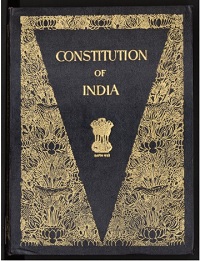Indian Polity and Constitution GK MCQs
Overview:
| Questions and Answers Type: | MCQs (Multiple Choice Questions). |
| Main Topic: | General Knowledge. |
| Sub-topic: | Indian Polity and Constitution. |
| Number of Questions: | 5 MCQs. |

Indian Polity and Constitution MCQs (Multiple Choice Questions) with answers for various state exams and UPSC civil services, SSC, banking, MPSC, UPPSC, MPPSC etc. Exams. Learn and prepare Objective type Questions on Indian Polity and Constitution.
1. Which one of the following acts constitutes the first Law Commission in British India?
- Regulating Act 1773.
- Charter Act 1853.
- Charter Act 1833.
- Goverment of India Act 1858.
Answer: (c) Charter Act 1833.
Solution: The features given in the Charter Act 1833 are: 1) Governor General of Bengal was designated as the Governor General of India. 2) Bombay and Madras presidencies lost their legislative powers. 3) Law Commission was constituted and the laws made from these acts were named as acts. 4) EIC ended its commercial activities. 5) Law member was added as the fourth member of the Governor General's Council.
Solution: The features given in the Charter Act 1833 are: 1) Governor General of Bengal was designated as the Governor General of India. 2) Bombay and Madras presidencies lost their legislative powers. 3) Law Commission was constituted and the laws made from these acts were named as acts. 4) EIC ended its commercial activities. 5) Law member was added as the fourth member of the Governor General's Council.
2. Which one of the following acts introduced open competition to recruit civil services?
- Charter Act 1833.
- Goverment of India Act 1858.
- Pitts India Act 1784.
- Indian Council Act 1861.
Answer: (a) Charter Act 1833.
Solution: The Charter Act of 1833 introduced Open competition for civil services recruitment. Macaulay Committee was appointed for this matter in 1854.
Solution: The Charter Act of 1833 introduced Open competition for civil services recruitment. Macaulay Committee was appointed for this matter in 1854.
3. Under Indian Council Act 1861, who could issue an Ordinance during an emergency?
- Governor General of Bengal.
- Viceroy.
- Governor General of India.
- Central Legislative Council.
Answer: (b) Viceroy.
Solution: The main features of the Indian Council Act 1861 were 1) Viceroy could appoint Indians as non Official members of his council. 2) New legislative councils were established in Bengal, NWFP, and Punjab. 3) Viceroy can issue ordinances during emergencies and will be valid for 6 months.
Solution: The main features of the Indian Council Act 1861 were 1) Viceroy could appoint Indians as non Official members of his council. 2) New legislative councils were established in Bengal, NWFP, and Punjab. 3) Viceroy can issue ordinances during emergencies and will be valid for 6 months.
4. The Constituent Assembly was first proposed by
- Jawarharlal Nehru.
- Motilal Nehru.
- M.N. Roy.
- Sachidanand Sinha.
Answer: (c) M.N. Roy.
Solution: M.N. Roy first proposed the Constituent Assembly in 1934.
Solution: M.N. Roy first proposed the Constituent Assembly in 1934.
5. Which of the following is not a salient feature of the Indian Constitution?
- Written Constitution.
- Federal structure.
- Parliamentary form of government.
- Decentralised Judiciary.
Answer: (d) Decentralised Judiciary.
Solution: The salient features of the Indian Constitution are 1) Lengthiest written Constitution. 2) Drawn from various sources. 3) Blend of rigidity and flexibility. 4) Federal system. 5) Parliamentary form of government. 6) Integrated and Independent Judiciary. 7) A secular state.
Solution: The salient features of the Indian Constitution are 1) Lengthiest written Constitution. 2) Drawn from various sources. 3) Blend of rigidity and flexibility. 4) Federal system. 5) Parliamentary form of government. 6) Integrated and Independent Judiciary. 7) A secular state.
General Knowledge Questions
Indian Polity and Constitution
Indian Polity and Constitution GK MCQs-1
Indian Polity and Constitution GK MCQs-2
Indian Polity and Constitution GK MCQs-3
Indian Polity and Constitution GK MCQs-4
Indian Polity and Constitution GK MCQs-5
Indian Polity and Constitution GK MCQs-6
Indian Polity and Constitution GK MCQs-7
Indian Polity and Constitution GK MCQs-8
Indian Polity and Constitution GK MCQs-9
Indian Polity and Constitution GK MCQs-10
Indian Polity and Constitution GK MCQs-11
Indian Polity and Constitution GK MCQs-12
Indian Polity and Constitution GK MCQs-13
Indian Polity and Constitution GK MCQs-14
Indian Polity and Constitution GK MCQs-15
Indian Polity and Constitution GK MCQs-16
Related Topics
Basic General Knowledge
Biology
Books and Authors
Chemistry
Famous Places
Indian Famous Personalities
Important Dates and Days
Indian Art & Culture
Indian Economy
Indian Environment and Biodiversity
Indian Geography
Indian Ancient History
Indian Medieval History
Indian Modern History
Indian Polity and Constitution
Indian Organizations
International Organizations
Physics
Physical Geography
Sports
World Geography